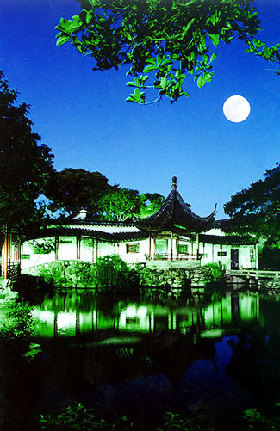The Master-of-Nets Garden
( chinadaily.com.cn )
Updated: 2011-09-21
|
|||||||||

The middle part of the garden has a pond in the center covering about 440 sq.m. with a small bay to the northwest and a streamlet to the southeast giving the impression of infinity. It is curved round by a roofed walkway, natural-looking mountains made from yellowstones piled up in layers forming hollows and caverns within, a tiny arch bridge called "the Leading to Quietude", and a number of delicate and well-proportioned pavilions, namely the Washing-My-Ribbon Pavilion over the water, the Moon Comes with Breeze Pavilion, the Prunus Mume Pavilion and the Duck-Shooting Veranda. The Washing-My-Ribbon Pavilion over the water is the best viewing place of the garden. The idea comes from a fisherman's song in the works of Mencius, saying, "If the water of the Surging Wave River is clean, I wash the ribbon of my hat; if the water of the Surging Wave River is dirty, I wash my feet." The same is true to the name of the garden - "Master-of -Nets".
The northern part of the garden features studies and studios with beautiful garden courts. Some noteworthy places include the Peony Study. the Watching Pines and Appreciating Paintings Studio,the Meditation Study, the Five Peaks Library and the Cloud Stairway Room. With white-washed walls as their backdrop ,stones bamboo, Prunus mumm and Musa basjoo partly concealed by windows and buildings have incredibly come to form numerous picturesque scenes.

In sum, there are scenes beyond scenes,and gardens within the garden.Many buildings are perfectly well-spaced instead of being crammed. A small area of water and stone is made to seem large. Based on illusion, the garden is full of change, capturing the effect of boundlessness,and achieving a unity of part and whole. The Master-of-Nets Garden serves to illustrate how the few surpasses the many and the small exceeds the large.
Today the Master-of-Nets Garden has 22 buildings, 2 doors with richly carved earthen ornamentation, 15 plate aux, 9 parallel couplets,15 brick and stone carvings, 32 stelae, and 8 rare species of old trees, namely Sabina Chincherinchee, Pinus bungeana, etc. falling into 6 catalogues.